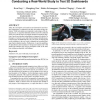Free Online Productivity Tools
i2Speak
i2Symbol
i2OCR
iTex2Img
iWeb2Print
iWeb2Shot
i2Type
iPdf2Split
iPdf2Merge
i2Bopomofo
i2Arabic
i2Style
i2Image
i2PDF
iLatex2Rtf
Sci2ools
221
Voted
AUTOMOTIVEUI
2015
ACM
2015
ACM
Introducing novel technologies in the car: conducting a real-world study to test 3D dashboards
Today, the vast majority of research on novel automotive user interface technologies is conducted in the lab, often using driving simulation. While such studies are important in early stages of the design process, we argue that ultimately studies need to be conducted in the real-world in order to investigate all aspects crucial for adoption of novel user interface technologies in commercial vehicles. In this paper, we present a case study that investigates introducing autostereoscopic 3D dashboards into cars. We report on studying this novel technology in the real world, validating and extending findings of prior simulator studies. Furthermore, we provide guidelines for practitioners and researchers to design and conduct real-world studies that minimize the risk for participants while at the same time yielding ecologically valid findings. Keywords Automotive UIs; real world study; stereoscopic 3D Categories and Subject Descriptors H.5.2 [Information interfaces and presentation (e.g....
| Added | 16 Apr 2016 |
| Updated | 16 Apr 2016 |
| Type | Journal |
| Year | 2015 |
| Where | AUTOMOTIVEUI |
| Authors | Nora Broy, Mengbing Guo, Stefan Schneegass, Bastian Pfleging, Florian Alt |
Comments (0)

